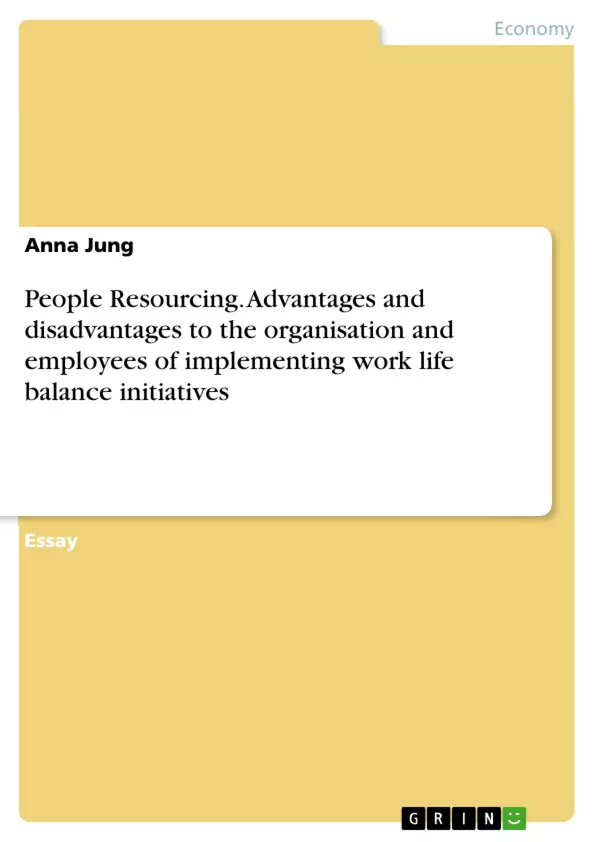Achieving the right balance between working and non-working life is a continuing challenge for many employees, particularly for British men who are working the longest hours in the EU countries (Green, 2013). According to the Work-Life Balance Employee Survey (Tipping et al., 2012:92) 54 per cent of employees overall agreed or strongly agreed with the statement that “It’s the employer’s responsibility to help people balance their work with other aspects of their life”. Even if 57 per cent of Britain’s workforce are satisfied with their work-life balance (WLB) (CIPD, 2013), only 37 per cent report that their organisation provides support to manage their work-home interface (CIPD, 2012).
However, in recent years WLB has become a dominant aspect for the vast majority of employers (Straub, 2007). Three-quarters of public organisations provide WLB policies and practices (Visser & Williams, 2006). Nevertheless, whether the underlying motivation behind this increasing activity is to fulfil their operational and organisational requirements or truly to satisfy the employees’ needs is arguable. Key factors driving this development are, in particular, demographic and social change, which have led to a greater participation of women in the workforce and increased employee concern with a better balance between work and home life (Major, 2006; Taylor, 2010). With this, a greater demand for atypical work arrangements has emerged. Furthermore, advances in technology enable to work at any time and any place which thus could contribute to a better integration of employees work and home activities.
Still, there is some disagreement among HR academics and practitioners about the benefits and challenges regarding this concept. The objective of this essay is to critically review the advantages and disadvantages of establishing WLB programmes to both organisations and employees. First of all, in order to set the scene for the examination of the relevance of this notion to both parties, the key term WLB will be defined and current examples of different initiatives offered by employers will be given. After that, benefits and challenges associated with WLB practices will be presented. Two case studies will provide examples of how other organisations have addressed this issue and what the beneficial effects have been. Finally, based on these expositions, the main findings will be summarised and evaluated. [...]
Table of Contents
- Introduction
- Defining Work-Life Balance (WLB) and WLB Initiatives
- Benefits and Challenges of Establishing WLB Programmes
- Case Studies
- Conclusion
Objectives and Key Themes
This essay critically examines the advantages and disadvantages of implementing work-life balance (WLB) programs for both organizations and employees. The author explores the definition and types of WLB initiatives and analyzes the potential benefits and challenges associated with their implementation.- Defining work-life balance and exploring its complexities
- Examining the various initiatives offered by employers to promote work-life balance
- Analyzing the benefits of WLB programs for both organizations and employees
- Identifying the challenges and potential drawbacks of implementing WLB programs
- Presenting case studies of organizations that have implemented WLB programs and their outcomes
Chapter Summaries
- Introduction: The essay introduces the topic of work-life balance, highlighting its growing importance and the challenge of achieving the right balance between work and personal life. It outlines the essay's objectives and structure.
- Defining Work-Life Balance (WLB) and WLB Initiatives: This section delves into the definition of work-life balance, acknowledging its diverse interpretations and the difficulty in reaching a universal consensus. It discusses the different types of WLB initiatives offered by employers, including structural and cultural support mechanisms.
- Benefits and Challenges of Establishing WLB Programmes: This section explores the potential benefits of implementing WLB programs for both organizations and employees. It emphasizes the positive impact on employee attraction, retention, motivation, and engagement. The section also discusses potential challenges and criticisms related to WLB initiatives, such as the controversial relationship between WLB and productivity.
Keywords
This essay focuses on the complex topic of work-life balance, examining the advantages and disadvantages of implementing work-life balance programs for organizations and employees. Key themes include the definition and implementation of work-life balance initiatives, the benefits and challenges associated with such programs, and the impact of work-life balance on organizational performance and employee well-being.- Citation du texte
- Anna Jung (Auteur), 2013, People Resourcing. Advantages and disadvantages to the organisation and employees of implementing work life balance initiatives, Munich, GRIN Verlag, https://www.grin.com/document/268120



